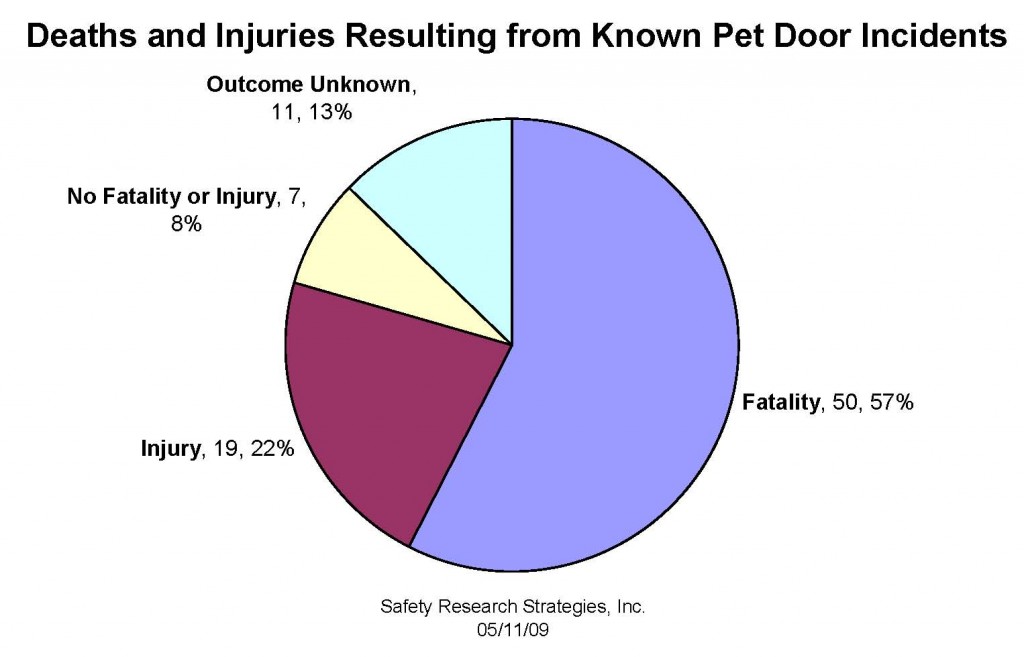
May 12, 2009
ORLANDO, FLORIDA – Matthew Ranfone was only two years old when he slipped out of his Orlando home, into an enclosed patio area and through a pool fence into the backyard pool. His parents found him minutes later floating face down. Matthew died 13 days later from the injuries sustained in the near drowning.
It’s a scenario well-known to a handful of child injury specialists – especially those who study the morbidity data in warm weather states. In fact, since 1996 there are nearly 100 documented cases of children endangered after exiting the home via a pet door. Nearly three-quarters resulted in injury or death. Mathew’s mother, Carol Ranfone, had no idea at the time that her son could easily escape through the small opening, but she is determined to warn other parents.
May 7, 2009
WASHINGTON, D.C. — Tire retailers are in the midst of an oh-my-gosh-the-sky-is-falling meltdown over a National Highway Traffic Safety Administration tire maintenance public education program. Specifically, the retail arm of the tire industry is quivering over the possibility that groups outside of the industry would be tapped to run it.
May 1, 2009
SACRAMENTO, CA – One of the nation’s first laws to require tire dealers to disclose the age of each tire prior to sale or installation cleared an important hurdle Tuesday, when the California state legislature’s Assembly Business and Professions committee passed it by a vote of 6 to 4.
February 1, 2009
Reprinted from The Safety Record, V6, I1
VINALHAVEN, ME – The U.S. Consumer Product Safety Commission has opened a probe in December 2008 into the strangulation death of a two-year-old who became entangled in the mesh netting of his crib tent.
Noah Thompson of Harvard, Mass., was strangled when his head got stuck between the mattress and mesh covering that was placed over his portable crib. His parents, Marc Thompson and Lisa Rosen, told state police that they had used the netting to prevent their son from climbing
out of the crib.
Reprinted from The Safety Record, V6, I1
WASHINGTON, D.C. – As the National Highway Traffic Safety Administration’s effort to write a new roof strength standard drags into its fourth year, the Insurance Institute for Highway Safety has gone ahead and created one that is far more stringent than anything the agency has proposed.
Beginning in 2010, automakers who want IIHS’s coveted Top Safety Pick designation will have to build vehicle roofs with a 4.0 strength-to-weight ratio – far above the timid 2.5 ratio the government has been contemplating for its amended standard. The IIHS estimated that vehicles that could meet this new strength standard could reduce injury risk to occupants by 40-50 percent. In January, the insurance advocacy group informed manufacturers about its new requirement for vehicle roofs to win its highest honor. The industry greeted the news with the “can’t-do” spirit that characterizes its reaction to nearly every safety improvement.
Reprinted from The Safety Record, V6, I1
WASHINGTON, D.C. – In 2005, Congress funneled $2.8 million to the University of Oklahoma as an earmark in the Safe, Accountable, Flexible, Transportation Equity Act, a Legacy for Users, to conduct a motorcycle crash causation study. But a series of missteps have caused the study to languish and, ultimately, may result in its demise.
December 1, 2008
Reprinted from The Safety Record, V5, I6; Nov/Dec. 2008
WASHINGTON, D.C. – The Designated Seating Position Final Rule has produced confusion around its measuring procedures and provoked controversy for its preemption clause and lack of statistical foundation as the Bush Administration tries to stampede another regulation to completion.
Researchers from the Center for Injury Research and Prevention at the Children’s Hospital of Philadelphia looked at the effect of reported deformation of the front seat back rearward on the injury risk to children seated in the rear in a rear-impact crash.
Dr. Kristy Arbogast, Associate Director of Engineering for The Center for Injury Research and Prevention at CHOP, said that the study evolved from crash investigations conducted by their research team as part of several research projects. Researchers took note of several crashes in which a child seated in the rear of the vehicle suffered facial injuries in a rear-impact crash.
Reprinted from The Safety Record, V5, I6; Nov/Dec. 2008
CROWNSVILLE, MD. – Ford may have won the public relations battle in 2000, when the blame for 173 Explorer rollover deaths fell on Bridgestone-Firestone’s Wilderness ATX tires, but the motoring public has turned out to be the real loser. According to a new analysis, after a brief dip, the number of Explorer rollover deaths involving a tire failure has risen to significantly higher levels than before the tires were recalled.
Reprinted from The Safety Record, V5, I6; Nov/Dec. 2008
OXFORD, NC-One year after a fatal crash and seven months after the National Highway Traffic Safety Administration launched a defect investigation into 30 million Chinese-manufactured tire valve stems that could crack prematurely, Dill Air Control Products has finally announced a recall.